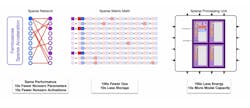Add AI Acceleration with This Tiny Coprocessor
What you’ll learn:
· How to add artificial intelligence acceleration to a host microcontroller.
· How to add always-listening keyword detection using less than 100 mW.
Artificial-intelligence (AI) developers are improving performance of AI and machine-learning (ML) models through a range of techniques like DeepSeek. Addressing model sparsity is one of these methods. While much of this focus is on high-end, cloud-based solutions, it’s equally applicable to low-power embedded solutions.
I recently talked with Sam Fok, CEO at Femtosense, about how sparsity and other techniques (Fig. 1) enable them to provide very low-power hardware for AI edge computing. Sparse matrices are common in machine-learning models since these weights are zero or close to it. Eliminating the need to perform arithmetic operations can reduce overhead by a factor of 100 or more.
Femtosense’s hardware is based on a sparse processing unit (SPU). This neural processing unit (NPU) is optimized to handle sparse data often consuming under 1 mW. The SPU-001 (Fig. 2) utilizes an SPI interface to connect to a host processor. The evaluation board contains an SPU-001 and plugs into a PMOD connector found on many processor evaluation boards. Femtosense has a single-chip solution: the AI-ADAM100 incorporates a Cortex-M0+ core and an SPU.
The company’s software tools can accept models from popular AI/ML frameworks like PyTorch and TensorFlow. Tools include software simulation that provides information about power requirements, latency, and memory footprint. The SPU-001 includes 1 MB of SRAM.
The SPU can handle a range of applications, but there’s a focus on audio applications such as keyword detection. The low-power requirements make it possible to implement an always-listening mode even when using battery power. Currently, the SPU can be found in some earbud applications.
>>Check out these TechXchanges for similar articles and videos
About the Author
William G. Wong
Senior Content Director - Electronic Design and Microwaves & RF
I am Editor of Electronic Design focusing on embedded, software, and systems. As Senior Content Director, I also manage Microwaves & RF and I work with a great team of editors to provide engineers, programmers, developers and technical managers with interesting and useful articles and videos on a regular basis. Check out our free newsletters to see the latest content.
You can send press releases for new products for possible coverage on the website. I am also interested in receiving contributed articles for publishing on our website. Use our template and send to me along with a signed release form.
Check out my blog, AltEmbedded on Electronic Design, as well as his latest articles on this site that are listed below.
You can visit my social media via these links:
- AltEmbedded on Electronic Design
- Bill Wong on Facebook
- @AltEmbedded on Twitter
- Bill Wong on LinkedIn
I earned a Bachelor of Electrical Engineering at the Georgia Institute of Technology and a Masters in Computer Science from Rutgers University. I still do a bit of programming using everything from C and C++ to Rust and Ada/SPARK. I do a bit of PHP programming for Drupal websites. I have posted a few Drupal modules.
I still get a hand on software and electronic hardware. Some of this can be found on our Kit Close-Up video series. You can also see me on many of our TechXchange Talk videos. I am interested in a range of projects from robotics to artificial intelligence.




